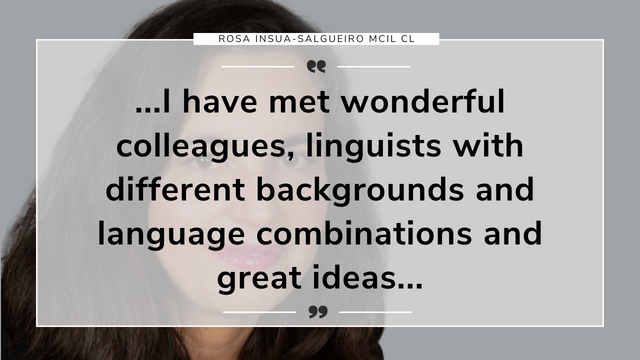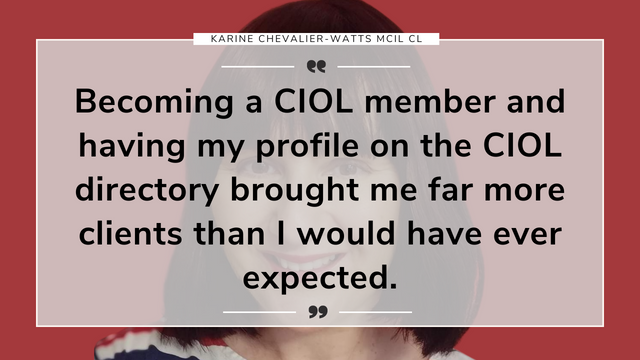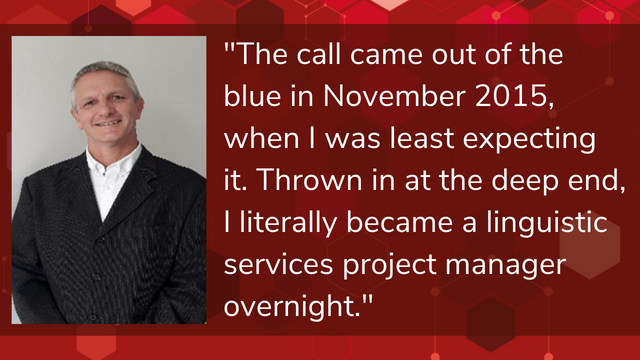-
QUALIFICATIONS
- For Linguists Worldwide
- For UK Public Services
- Preparation
- Policies & Regulation
-
MEMBERSHIP
- Join CIOL
- Membership grades
- NEW for Language Lovers
- Chartered Linguist
- Already a member?
- Professional conduct
- Business & Corporate Partners
-
ASSESSMENTS
- For Second Language Speakers
- English as a Second Language
-
TRAINING & EVENTS
- CPD, Webinars & Training
- Events & Networks
- CIOL Mentoring
-
NEWS & VOICES
- News & Voices
- CIOL eNews
- CIOL Awards
- The Linguist
- Jobs & Ads
-
RESOURCES
- For Translators & Interpreters
- For Universities & Students
- Standards & Norms
- CIOL & AI
- APPG
- In the UK
- UK Public Services
- Find-a-Linguist
Kick-start your career as a translator: Your questions answered
By Vasiliki Prestidge
At the CIOL Conference in March, Vasiliki Prestidge gave a presentation on how to kick-start your career as a translator. There wasn’t enough time at the conference to answer all your questions, so we sent them over to Vasiliki, and in this blog post she talks about: how to create your portfolio, address copyright issues, develop your specialism, navigate website vs LinkedIn options, offers advice for students, and more – read on!
It is recommended that your portfolio is a PDF file. PDFs are not easily editable. This means your portfolio will not be altered by anyone else. For even more security, you can also password-protect the PDF. A portfolio publicly available on a personal website might not be the best idea. A professional website can have a reference to your portfolio and the fact that you have one. There can be a call to action (CTA) prompting the website visitor to get in touch with you to ask to see your portfolio.
It's important to know why someone is interested in you, your portfolio, or your CV. On several occasions, random people would ask for my CV and portfolio, sometimes, out of simple curiosity. Why should they have this information about you? You should be able to control who knows what about you and your work, how much they know, and why.
A portfolio should ideally be electronic. This is the fastest, easiest way to share it with several potential clients. It can be attached to your prospecting email but remember that emails with attachments may end up in the spam folder. The prospecting email can refer to your portfolio, and the fact that you have one, and that you're happy to share it, if requested. This will keep the conversation going. In other words, don't give away everything you have from the first email. Another trick is to always try and close your emails with a question. This may encourage the recipient to write back to you.
If you’re worried about copyright, remember that your work is yours. It belongs to you. If in doubt, ask for permission from your clients, then include the translations in your portfolio. You can remove references to clients, brands, and product names.
It's important for translators, particularly young or new ones, to see themselves as equal with their clients be it agencies or direct. Nobody should be having power over what you can or cannot do with your own work, rates, conditions of work etc. If this is particularly challenging, then any other type of work can be published in your portfolio as long as it is work carried out by you. Meaning, do not take someone else's translation, publish it in your portfolio and present it as your own. You can translate an article, polish it to perfection and include that in your portfolio. Any work is work. It does not have to be commissioned, paid-for work. The whole point of the portfolio is to allow potential clients see what you are capable of.
In terms of whether clients should be listed in your portfolio or not, credibility should be resulting from the quality of your work. Sometimes, the bigger the client, the more difficult the relationship. Somehow, large organisations tend to come with tight budgets and unrealistic expectations. The portfolio is a tool to promote you and let your work shine through, regardless of who you did the work for. Clients can be listed elsewhere, in your CV for example, or LinkedIn.
Starting out can be very tough particularly in today’s climate. Practice, keep learning, keep developing, stay positive, have a plan, market yourself, and believe that translation can be a rewarding career. Don't let others disappoint you. Look for inspiration in your colleagues, but don't be a copycat. Search for your authentic self and be that. Set goals and track them. Stay consistent. It's not about motivation. It’s about discipline. Join your professional organisation for help and support and build a strong network.
Specialising is hard, especially at the beginning. It is useful to think of all the experience you may already have and build on that. Any work experience can be valuable, from working at a café, bar, or restaurant, to a hospital, or a bookshop.
Most professions have their own institutes or regulatory bodies. For example, if interested in becoming a legal translator, the Law Society is a good place to start from for additional training and networking. Similarly, the General Pharmaceutical Council (GPhC), or the General Medical Council (GMC), can be a starting point for resources, training, and networking opportunities.
Reading material from your specialisation field, listening to podcasts, or watching television programmes will also help you develop your specialism. Practice is essential. So, if you want to get into medical translation, then grab a medical article and start translating.
Marketing is critical, but marketing alone or social media on their own won’t bring results unless there is a method and a strategy behind what you do. There is a workshop on social media coming up. You can now register for it here. This will be a full day workshop with hands-on practice, and it will include Instagram. It will be taking place later this August and it will be online. Places are limited so make sure to secure your spot!
A LinkedIn profile, a Proz account and a business website are three completely different things none of which can replace the other. They all support your public profile and should work in synergy in lifting your name and building a story around your brand. Your online presence should be aligned with that of your clients’. In other words, if your clients are on LinkedIn, so should you.
Recordings of the three-day conference, including Vasiliki's full presentation, can be purchased here.
Filter by category
More
The Chartered Institute of Linguists (CIOL), Incorporated by Royal Charter, Registered in England and Wales Number RC 000808 and the IoL Educational Trust (IoLET), trading as CIOL Qualifications, Company limited by Guarantee, Registered in England and Wales Number 04297497 and Registered Charity Number 1090263.







